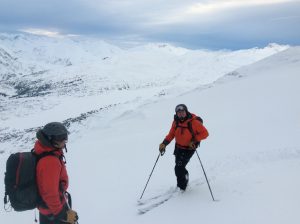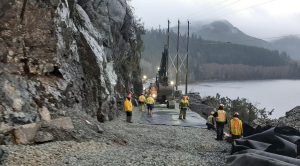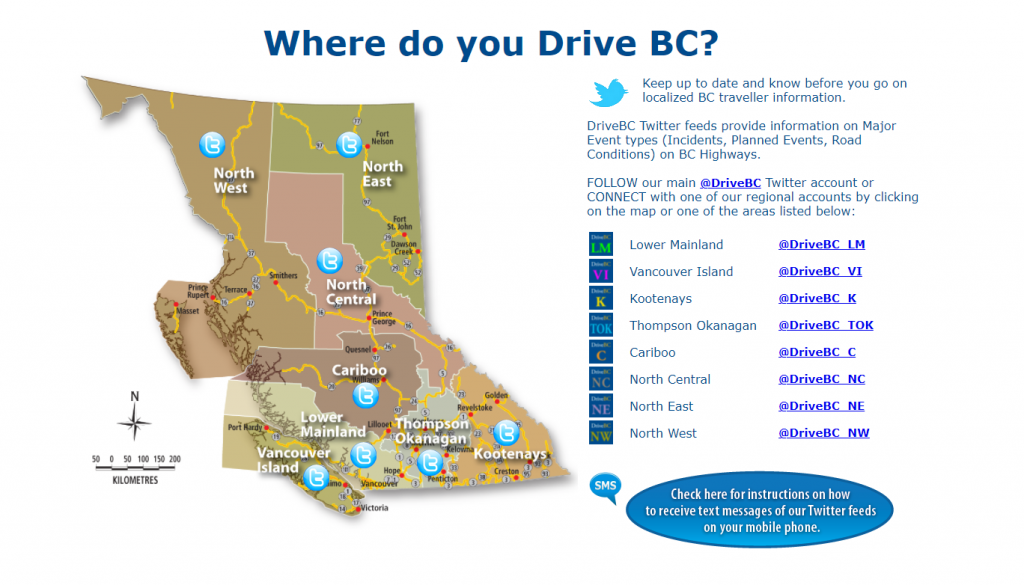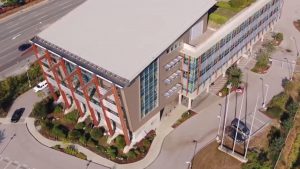
A small group of employees who work at the Transportation Management Centre of BC (TMC) in Coquitlam, has a big job getting BC highway information to travellers via DriveBC and other routes, 24/7.
The agents share current highway information with motorists via DriveBC and DriveBC’s nine Twitter accounts (one province-wide and eight regionally focussed). Their work extends beyond our traveller information system, to communicating on dynamic message signs and changing speed limit signs on certain sections of highway. They are also a lifeline to ministry colleagues working in remote, potentially hazardous locations.
We asked two agents, Amita Symons and Aidan Mouellic, to tell us what it’s like be part of this essential service at the ministry’s hub for highway information.
What does your job involve?
Aidan: Our primary role is to inform motorists and highway users of events occurring on the highway network. We accomplish this using our popular Twitter feeds, the DriveBC website and email service that we update, as well as dynamic message signs. The Variable Speed Limit Signs are another system we operate.
Our tasks change depending on the demands of the season. For instance, in winter we update overhead message boards with road conditions at a much greater frequency than in summer. In summer, we might be sharing information about highways closed due to major construction projects, forest fires, floods or slides.
We also assist staff from a variety of departments and ministries with transportation queries and whatever else may arise. This spring, I was on the phone with someone in Prince Rupert who was coordinating the COVID-19 vaccine rollout and had questions about a highway closure. You never know who will call and we wear many hats!
Amita: Firstly, we act as quality assurance for information that comes through the ministry and contractors and needs to be inputted into DriveBC.

Secondly, we support incident management and receive emergency calls from first responders about hazards such as avalanche control, land and rockslides, weather conditions that affect the roads and vehicle and police incidents, which we dispatch out to the correct maintenance contractors throughout the province. The contractors provide on-the-ground support and continue to update us on the situation – information we share with the public.
Other aspects of the job include performing safety check-ins with avalanche technicians working in the field to monitor them as they do avalanche control for about 1,390 avalanche paths in BC, as well as managing the province’s variable speed corridors, and monitoring the traffic webcams that are situated across the lower mainland and throughout the province.
Who do you work with?
Aidan: I work alongside ministry-employed agents as well as skilled contractors from Mainroad Group and Miller Capilano who operate the George Massey Tunnel, Cassiar Tunnel and the Lions Gate Bridge lane counterflow systems. Since we communicate events throughout the province, we are also in regular phone, email and radio contact with our ministry colleagues and various stakeholders from all corners of BC. We receive information about events, incidents and hazards from the RCMP, emergency responders, maintenance contractors, ministry staff, the media and the public – we essentially work with everyone!
Amita: Throughout the day while monitoring various incidents, I am in contact with area managers, emergency services, first responders, maintenance contractors for the 28 different areas across BC, and of course other TMC agents. As a newer agent, it has been an enlightening experience to see how many people are involved with making sure the highway system stays operational and functional. The maintenance contractors who operate the counterflow systems for the Lions Gate Bridge and the George Massey Tunnel also work out of the transportation management centre alongside TMC agents 24/7.
Why is this work important?
Aidan: Informing the travelling public of conditions and events that are affecting highways is crucial for motorists to make informed decisions. Having as much information as possible before you head to your destination increases the likelihood of it being a pleasant trip. TMC agents are trained to gather and broadcast critical information so that travellers have as much information as possible. Every task we do is based on keeping people safe – it feels good to be looking out for people and serving British Columbians.
Amita: Communicating incidents and hazards to road users allows them to know what to expect and be better prepared to travel, whether they are headed out for their daily commute or for a longer road trip. Facilitating the timely dispatch of contractors to incidents is important because it ensures that traffic is directed safely while the incident is being managed and that the road is cleared as soon as possible.
What skills and traits are needed for the work?
Amita: We work with various computer applications and the job requires a high level of attention to detail and multi-tasking. The ability to prioritize is key, as sometimes we can be handling five different things happening all at once. Empathy is also important for the role. When communicating with traveling public though social media or with those working in the field it really helps to be compassionate towards the fact that they may be in a difficult or stressful position.
Aidan: The ability to remain calm under pressure as well as the ability to prioritize tasks are perhaps the most important traits. You can go from being calm one moment, to getting a call about a major rockslide blocking a highway the next. This can be nerve wracking – you need to recall what the procedure is and what the response has to be. If a major event is ongoing and you are getting other calls on top of that, it can start to feel overwhelming and this is when you have to prioritize tasks.
It’s important to know when to lean on your colleagues and ask for help, and when to offer assistance. We’re a team and we help each other out – this can make all the difference. Another major asset to being successful in the job is being comfortable speaking on the phone and using a variety of computer programs, often simultaneously.

What are the challenging aspects of your role?
Aidan: Agents work with a lot of autonomy and independence; we are trusted to make the right calls and decisions on our own when necessary. This can feel like a lot of pressure, especially with the variety of events that affect the highways, but with time and experience, you develop the necessary skills and confidence.
I completed my training and logged into our systems as an agent, the first day a state of emergency was declared in 2017 due to widespread, devastating forest fires. As a new agent, I often felt overwhelmed, especially with the high volume of public queries we were receiving on Twitter, but being able to help and guide people to safety felt really good and demonstrated the importance of timely and accurate communication during a crisis. We received a lot of messages of gratitude from affected British Columbians and it really showed how helpful social media can be during natural disasters and other emergencies.

Amita: Conveying information to the public can be challenging when they don’t know the big picture in a given situation. For example, we had an incident where crews were performing emergency work to repair an unsafe road surface during rush hour. Without knowing that the highway required immediate attention to ensure traveller safety, many people were frustrated that “road maintenance” was being done at a such a busy time. While we can’t always provide extensive details for every incident, providing as much consistent and accurate information as we can hopefully contributes to reducing frustrations for road users.
What are the rewards of your work?
Amita: BC is reliant on its highways for the transportation of goods and services, and this is especially true for smaller communities away from the lower mainland. I have always thought of the highway network as being like the “arteries” of the province in that way. It is rewarding to play a part in keeping this system functional when it is integral for so many people.
Aidan: Knowing that you are part of an organization that is doing everything it can within its power to ensure our highways are as safe as possible is a pretty good feeling. We may spend our time behind screens at the TMC but we get to speak with people from all around the province and through these conversations pick things up about them and what life is like where they are. I’ve learned so much about the varied and remarkable geography of our province.
It’s also really rewarding to work in a ministry that is filled with diverse and talented individuals; it’s been a privilege getting to meet so many interesting people. While COVID-19 has put a damper on this, I look forward to the office being full with co-workers again, and the annual Christmas party.

What kind of education/training do you have?
Aidan: I received a bachelor’s degree in communication studies from Capilano University, in 2019. My formal education gave me a solid foundation in communication principles but for a TMC agent, the training and guidance from senior agents is irreplaceable.
Amita: I have a bachelor’s degree in Geography with a minor in environment and a minor in world cinema from McGill university. I’m very grateful for all the training that I’ve received from senior TMC agents since I started working at the TMC – everyone is from different backgrounds and has different strong suits and ways of doing things and I think that this really strengthens the quality of service that we can provide as a team.
As the TMC provides the public with information 24/7, what kind of hours or shifts do you work?
Aidan: We have three shifts that we work – the morning, afternoon and night shift. The morning shift is from 6 a.m. to 2 p.m., the afternoon shift from 2 to 10 p.m., and the night shift is from 10 p.m. to 6 a.m. We typically will rotate through the shifts in blocks that are about six weeks in length so that they get fairly distributed. It can be challenging to maintain a healthy lifestyle while working shifts – staying on top of your sleep hygiene and other aspects of self care is crucial to adjust to the changes.
Amita: There are three 8 hour shifts that cover the 24 hours in a day. I am not a morning person, so I prefer the 2 pm to 10 pm afternoon shift or the 10 pm to 6 am night shift, but each shift has a different feeling to it. You really get a sense of the ebb and flow of people and traffic throughout the day. It’s been very cool to experience that from a sort of “bird’s eye” perspective as a TMC agent.
So, there you have it! The daily duties of TMC agents who channel information your way to keep your safe on your travels throughout BC.
For more about other careers in the Ministry of Transportation and Infrastructure, please check out these blogs:
>>> Boots on the Ground: A Day in the Life of a Road Area Manager
>>> What it Takes to Keep Bridges Upstanding and Safe
>>> Field Services: Outstanding Supervision Specialists
>>> What It’s Like to Be a Transportation All-Star
>>> Behind the Scenes with Our Highway Operations Managers
Do you have questions about the work of a TMC agent, or about other positions with the ministry? Ask us below!
Is highway 1 open from Spence’s Bridge to Goldman Provincial Park? Maps says it’s closed but can’t find anything on drive BC
Hello Brock.
The wildfire situation remains very dynamic. Please check DriveBC.ca and our Travel Advisory page for the most up-to-date information. Currently, Highway 1 is closed between Boston Bar and Lytton due to an active wildfire which, depending on where your map is routing you from, might be the closure you are seeing. The situation is changing rapidly, so again, please check DriveBC.ca for the most up-to-date info.
Safe travels.
The Sealcoating being done by an out of area Contractor, between Tete Jeaune and McBride was not shown initially a few weeks or months back and I called the local Maintenance contractor and eventually the info was put on your website. I have now driven this portion of Highway 16 last Tuesday and a week ago Tuesday and their is no more construction. I have called the local Maintenance Contractor twice now and yet this morning the advice of overnight Pilot Cars, 30 minute delays, etc. is still up and with a note of being updated July 13. I wonder if the Construction company has not updated you because they haven’t re- painted the lines yet? Or perhaps they are just defaulting on notifying you in general of their activities? But still, there is no 30 minute delay now. Can you update?
Hi Ernie.
Thanks for connecting with us and sharing your concerns. We spoke to staff in the area who let us know that they have already followed up with you directly over the phone about this. The information on DriveBC is in place until the contractual obligations for the project have expired, as there may be a chance that the contractor is back in the area to complete further works.
How long is the wait between Vanderhoof and Prince George ?
Hi Mark, thanks for reaching out. Unfortunately we don’t have an up-to-date estimate of wait times. Please also note that the TranBC site is only monitored during regular business days/hours.
We recommend you stay tuned to DriveBC for the best information on road and highway closure via their website, or on Twitter (their main account is @DriveBC, and their local account for your area is @DriveBC_NC).
Thanks for the great job
Thanks for the kind words, George!
You have no detour around the slide at big horn. Perhaps your university education is not the best for your job as you can go from Lytton to Lilloett to just north of cache creek. Light traffic only. 5 ton or less Highway is the original gold rush trail from Yale
I am interested in Hwy 99 work being undertaken to improve Transit and cycling between the Massey Tunnel and the Peace Arch border crossing. I have been told the pavement shoulders are being widened to accommodate a transit and cycling superhighway infrastructure. Where can I find details-particularly for the overpass crossings of railways in South Surrey?
Hi David,
Thanks for your interest in this major project. You will find more information here: https://www.highway99tunnel.ca/ Note that there is also an email for more specific questions about the Highway 99 Tunnel Program: Highway99tunnelprogram@gov.bc.ca
Are you currently hiring DriveBC agents?
Hi there Ian – all current and future opportunities with the BC Government are posted here: https://www2.gov.bc.ca/gov/content/careers-myhr
We encourage you to search for postings under the Ministry of Transportation and Infrastructure. Good luck!
Why was there not any information regarding hwy 19 closure at Superior Rd, north of Nanaimo on Christmas Day. We were driving home to Parksville at approximately 7:30 PM and were turned back. The police told us to check Drive BC to get updates. There was absolutely nothing about the closure, let alone updates. Had to call the RCMP non-emergent number to find out when the hwy was reopened. Do you think this is acceptable?
Hi Dennis,
Sorry for your frustration and I can understand the confusion. In this case, the road was closed by the RCMP for slippery conditions however they did not advise us of this, neither the maintenance contractor or TMCBC/DriveBC which is why it wasn’t on DriveBC.ca. We’re following up to avoid this in future.
Hi, thank you for all you do.
I live in vancouver, and a family member has passed away. I need to travel to Manitoba to be with my family. Will I be able to travel using Highway 3? I don’t know what to do. I would really appreciate some guidance. Thank you
Hello Foram – we are sorry to hear of your loss. Unfortunately, travel to attend a funeral is not considered essential at this time. Our priority right now is to keep commercial traffic moving, stabilize our supply chains, and make sure everyone gets home safely. This is unprecedented time in our province and the flooding and travel restrictions make this a very difficult time for anyone who may be grieving the loss of a loved one. These are temporary, short term measures that can be eased up as the situation improves. Crews are working to open highways as quickly as possible, so we encourage you to check frequently for updates on the latest road closures and openings.
Hi, thank you for your work.
I live in Princeton BC where, as you know H5A feeds into H3. I am watching the hundreds of trucks driving by and stacking up on the bridge across the Tulameen River.
With H3 being the only outlet to the Coast it is extremely important to have updated information.
I have been reading Drive.bc and notice that the updates are slow. At this time when there are accidents on the highway almost every day I wonder if the people at Drive.bc could
post news of incidents and clean ups on schedule.
My son is a driver, and he depends on this site. He stayed with us last night on his way back from a trip to the interior. He was looking at Drive.bc this morning and the site hadn’t been updated.
I know you have many other roads to monitor, but at this time could you focus more closely on the Hope Princeton Highway? It is, after all, the sole route ajoining the Interior and the Coast.
Thank you again.
Hello and thanks for your comment. We know just how important this tool is to travellers, especially now that routes are restricted.
Updates to DriveBC are initiated by our ministry staff or maintenance contractors on the scene, including details (if available) like location, what’s going on, when the next update will be, whether there’s a detour and when the estimated opening time is planned.
Once the update is inputted into the system, it’s displayed on the website within minutes. Ministry staff and maintenance contractors make every effort to stay informed, providing updates on DriveBC quickly, regularly and as conditions change. Sometimes, though rarely, there can be discrepancies or delays in information to DriveBC. There are a few reasons this might happen:
Emergency Services – Sometimes, other first responders like the RCMP need to close a road, and they do so before letting our staff and maintenance contractors know or before we arrive on the scene. This may cause a discrepancy or delay between what’s happening on the highway and what is actually being posted to DriveBC.
Safety First – Ministry staff and maintenance contractors are often involved directly with the emergency response taking place on scene, so if urgent actions need to be taken right away, this may cause a delay in inputting data.
Connectivity – Gaps in communication systems (lack of cellular coverage means having to radio in updates to someone who can input data into the system).
Emergency On Scene – It can sometimes be difficult to estimate opening times due to the thorough investigations that occur alongside motor vehicle incidents. Often, investigators must be called into remote locations and the road cannot be opened until they finish their work.
We hope that this information is helpful and appreciate your understanding as we work to communicate all closures and delays to the travelling public during this challenging time. Safe travels to you and your son.
Hi, I have Siblings in Kamloops. Am I able to visit them from Vancouver? I want to give some supplies and help from Vancouver.
Hi there Michael – at this time your trip would not be considered essential. If your sibling needs support in the Kamloops area, we encourage you to have them reach out to Emergency Services there. Hope that this is helpful and thanks for reaching out to confirm.
I live in Chilliwack and have a very important pediatrician appointment for my 8 month old son in Abbotsford on Dec 1st. If highway 1 is still closed will I be able to use highway 7 to get to it? I cannot miss this appointment. I don’t know what to do.
Good morning Anita,
Medical appointments are considered essential. Here’s the link to the list of reasons for essential travel. https://www2.gov.bc.ca/gov/content/natural-disaster/support/restrictions
I have to travel from Kamloops BC to Chilliwack for a previously scheduled cataract surgery on December 16 2021 at Chilliwack Hospital. Will I be able to travel via Highway #1 Trans Canada under the “essential travel” order for this procedure? Thank you.
Hi there Marilynn – thanks for connecting with us here. At this time, BC Highway 1 is closed, however BC Highway 3 is open to essential travel and medical procedures does fall under the essential travel category. Please continue to check DriveBC.ca for updates closer to your scheduled date. Safe travels.
Thank you for your great service!
If highway 99 south is closed on Nov. 26, is highway 12 to lytton and highway 1 from lytton to hope open for essential travel. We have to bring a family member from lillooet to the airport( return to a
principal residence) on Nov. 26
Thank you
Hello Gerhard. Travel is allowed for people looking to return to their primary address. Under this language, she should be allowed to travel to Vancouver for her flight and you should be able to return home after taking her to the airport. Hope that this is helpful. Here’s the link to more info: https://www2.gov.bc.ca/gov/content/natural-disaster/support/restrictions
My mother-in-law needs to return to her country. ( Poland )Highway 99 was closed and we had to rebook her ticket at a cost of $ 300. She is also out of her medications.
Her next flight is on Nov. 26 out of Vancouver. Highway 99 is open only for essential travel.
We live in Lillooet. Can we bring her to Vancouver? and use highway 99 to bring her and then return the same day?
Hello Gerhard. Travel is allowed for people looking to return to their primary address. Under this language, she should be allowed to travel to Vancouver for her flight and you should be able to return home after taking her to the airport. Hope that this is helpful. Here’s the link to more info: https://www2.gov.bc.ca/gov/content/natural-disaster/support/restrictions
Is highway 7 open from Aggiszi to Mission?
I live in Chilliwack and need to get to Abbotsford Friday morning.
Hello Dick – our apologies for the delay in this response. As you no doubt already know, Highway 7 has re-opened and we hope you were able to make your journey safely.
Is hwy 4 Kennedy Hill, fully open on Saturday & Sunday? We’re leaving Tofino tomorrow (Saturday) & have to be in Nanaimo to catch a ferry. We’re trying to plan a departure time from Tofino
Hi Linda,
Sorry for the delay. DriveBC is our 24/7 travel information resource. Another great resource for Kennedy Hill Hwy 4 work is the project’s Facebook page: https://www.facebook.com/eac.bc.ca.kennedy.hill/posts/3087921571424306
Can you tell me is hwy 95 a rough hwy for semis to travel from bull river and golden
Hi there Tim,
Thanks for your question. Highway 95 is fully paved between Bull River and Golden. Hope this helps!
Hello, i plan a trip from Parksville to Tofino on sept 30th, when you say …release at top of the hour… on Hwy 4 , what do you mean?
Good morning Louis – thanks for your question. Release at the top of the hour means that traffic being stopped to wait at the construction site will be let through the site at the top of the hour (at 11 am or at noon, etc.). Therefore, if you arrive at the eastern edge of the Kennedy Hill construction site between 2 pm and 3 pm, you can expect to wait until 3 pm, when the queue will be shuttled through the site and the site closed until the top of the next hour. We hope that this is helpful
I’m having difficulty finding information about getting my private 5th wheel and truck weighed (per axle). There is a ‘self-weigh’ near me in Saanich however the electronic sign always seems to say “CLOSED”. Wondered if you could provide a number for other nearby sites or a phone number. Thanks.
Hi Richard,
Thanks for connecting with us here. You can contact the closest inspection station to determine the best time to use the scale. Here is a list of inspection station contact numbers. Safe travels!
https://www.th.gov.bc.ca/cvse/inspection_stations.htm
Please please please save the forests by putting up signs along highways about throwing cigarettes out the car window. Sad to say, I have been a passenger on many occasions and have witnessed people doing this in extreme heat waves.
Alot of people do it out of a 25 year habit without even thinking about it (pure carelessness)or they have the psychological complex “it will not be MY cigarette that causes disaster”…I witnessed a fire starting as I demanded the driver pull over so I could find his cigarette in hot dry grass. I had a jug of water.Luckily.
Please, it costs so little to put up reminder signs on highways of this major cause for forest fires, death, and destruction…if I saves one life it will be worth the cost and effort.
Hello Allison and thank you for your message. We continue to share and promote fire smart safety messaging across all our social platforms, as well as on our overhead messages where applicable. We have included a link below to a sample of some of our content to that end. We will share your suggestion for additional roadside messaging to our traffic engineers for their consideration. Again, thank you. Safe travels.
https://www.tranbc.ca/2014/07/16/only-you-can-prevent-roadside-wildfires/
drive bc I’ve got a question for you why do you guys have all these hwy signs, they are so useless & end ul causing more problems because you guys think updating your signs & internet information every 8 hours or 12 hours when the weather has completely changed? I’ve gonna uo hwy 5 when it says chain up lights are on & it’s as sunny as an August day & no chain up on your company is so unreliable its actually pointless but good effort. maybe try a little harder & things will be much smoother on the roads with less accidents. try harder guys
Thanks for sharing your opinion with us, Blake. We have shared it forward with the DriveBC team.